Vegetables are healthy snacks for humans and dogs alike. Not only that, but they’re an essential part of both of our diets! They provide the vitamins and nutrients your dog needs to survive.
However, not all vegetables that are healthy for humans can be fed to dogs. If you don’t know better, it can be easy to make a mistake and feed a dangerous food while thinking you’re giving them something healthy!
Vegetables that can poison your dog include mushrooms, rhubarb, those in the Allium family like onions and garlic, and some in the nightshade family such as unripened tomatoes or uncooked potatoes. If your dog eats a toxic vegetable, call a veterinarian right away.
In this article, we’ll talk about 11 popular vegetables that are toxic or otherwise unsafe for dogs to eat. Remember that this isn’t an exhaustive list–meaning a veggie isn’t safe just because it’s not listed here.
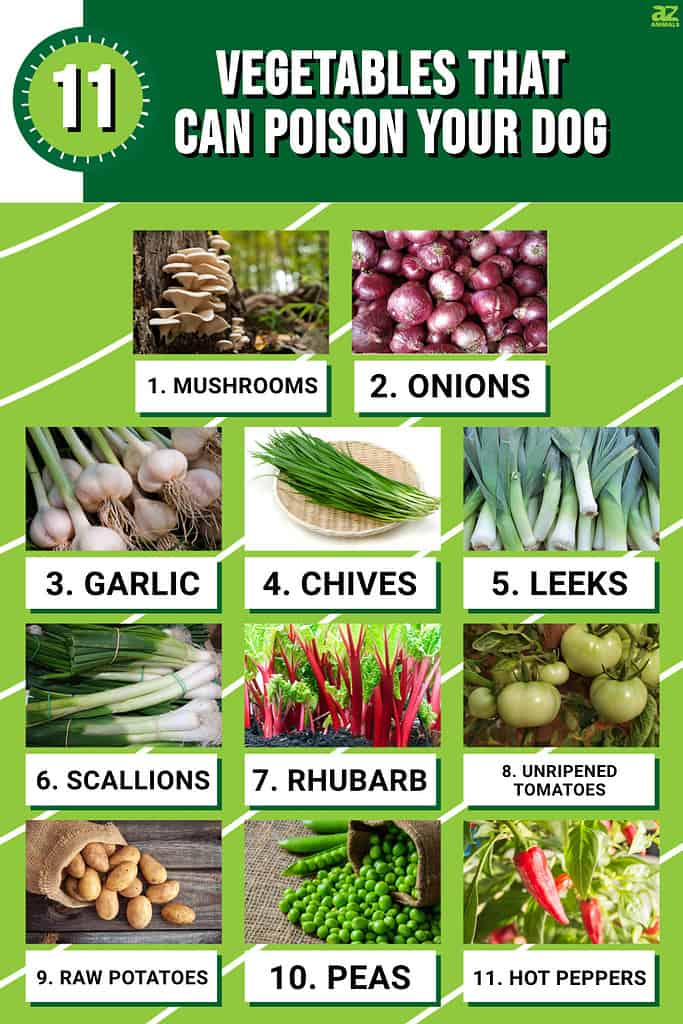
1. Mushrooms
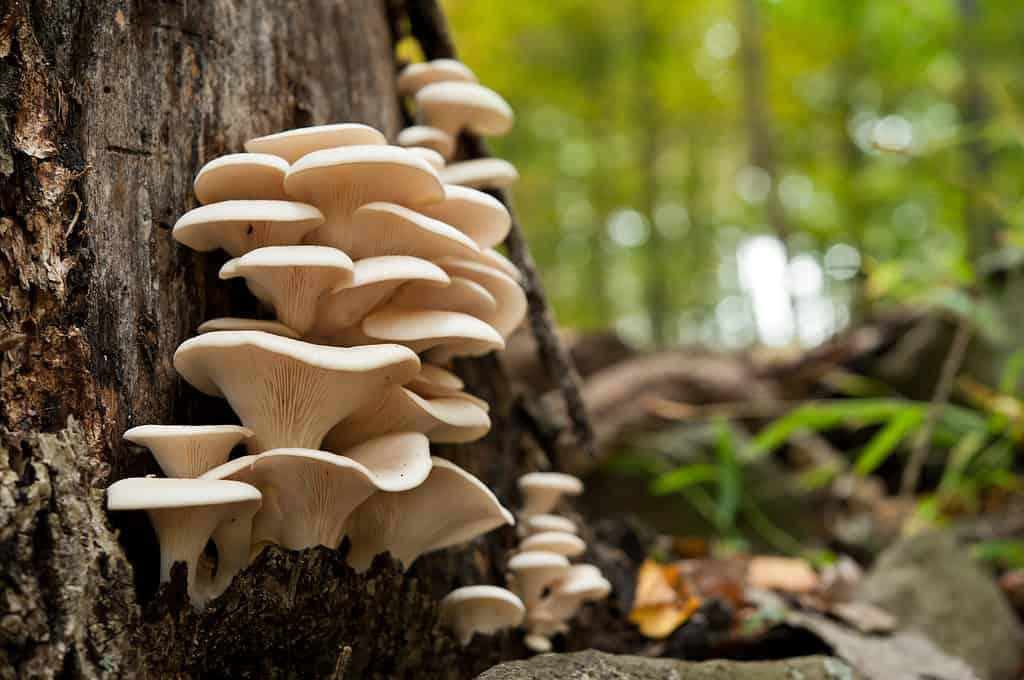
If you have mushrooms growing in your yard, your dog might need constant supervision so they don’t eat them.
©iStock.com/lensblur
Wild mushrooms can be toxic to dogs, so it’s best to avoid feeding them altogether. That said, the mushrooms you buy at the grocery store are safe in small amounts.
While most of us know to avoid eating or feeding our dogs unidentified mushrooms, sometimes they can sprout in your yard or other outdoor places your dog frequents, like around the neighborhood where you walk or at a local park.
It’s important to ensure they aren’t eating these! Longterm; every dog should have a solid “leave it” and “drop it” cue in case they get ahold of dangerous things like toxic mushrooms. If they grow in the yard, your dog might need constant supervision, so they don’t eat them.
Short-term, keeping your dog on a short leash or muzzling them can help stop them from eating mushrooms they shouldn’t.
2. Onions

Dogs can die of onion poisoning
, especially if they don’t receive veterinary treatment.
©Godai Das/Shutterstock.com
Dogs cannot eat onions or any part of an onion plant. This includes foods with onion powder, which is more concentrated and thus even more toxic than whole food.
A medium-sized dog can experience dangerous toxicity levels by eating just one onion or the equivalent.
Symptoms of onion toxicity include lethargy, weakness, decreased appetite, vomiting, pale gums, increased heart rate, excessive panting, fainting, and red-colored urine.
Dogs can die of onion poisoning, especially if they don’t receive veterinary treatment. If your dog eats onions, call your nearest emergency vet clinic for help immediately.
3. Garlic
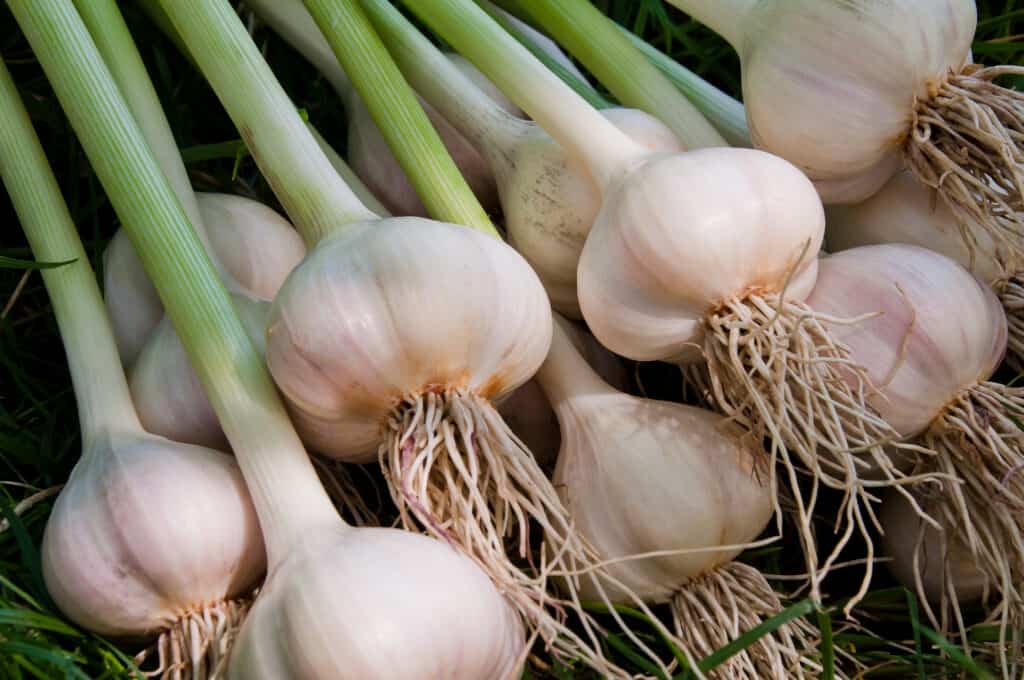
If they’ve eaten garlic, it’s important to get your dog to the vet immediately.
©Liubomyr Tryhubyshyn/Shutterstock.com
Garlic is another very toxic vegetable for dogs. Like onions, it’s toxic in all forms, including fresh, cooked, and powdered.
Unfortunately, garlic is even more toxic than onion–it’s up to five times more potent. Like onions and other Alliums, garlic damages a dog’s red blood cells. This can result in all of the symptoms listed in the “onion” section above.
If they’ve eaten garlic, it’s important to get your dog to the vet immediately. Don’t wait for an appointment or even for them to show symptoms–as some damage might be invisible, and catching the poisoning early can prevent your dog from getting sick in the first place.
Another important note is never to induce vomiting at home unless instructed otherwise by a veterinary professional. This can actually do more harm than good in some cases.
4. Chives
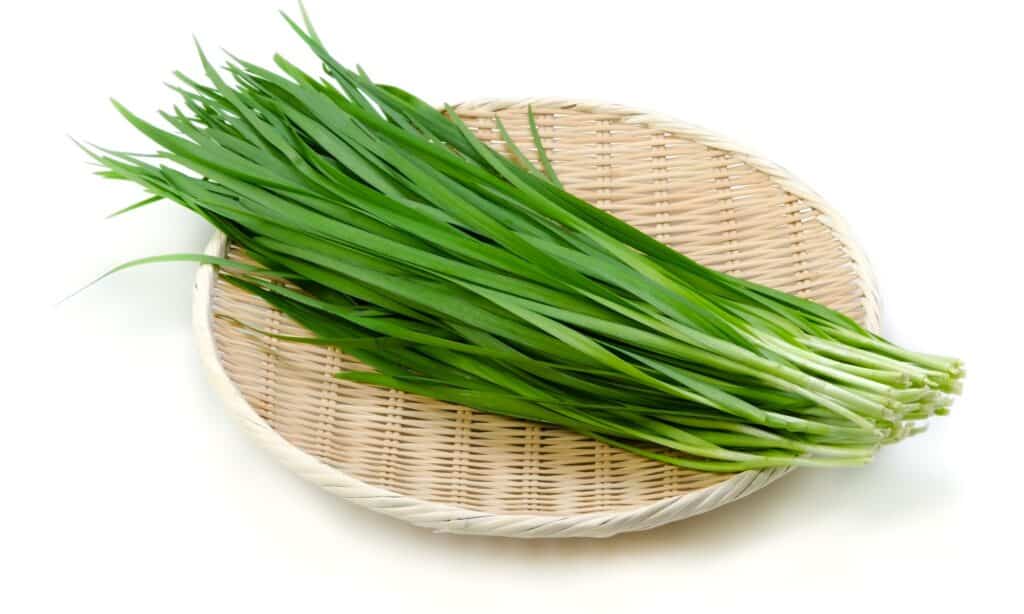
Chives, in particular, can cause damage to red blood cells, stomach upset, and weakness.
©iStock.com/eye-blink
Chives are another food belonging to the Allium family of plants, and thus also toxic, like the foods above. According to Pet Poison Hotline, some Japanese breeds like Akitas and Shiba Inus are more sensitive to Allium toxicity.
Chives, in particular, can cause damage to red blood cells, stomach upset, and weakness. Symptoms might not appear until several days after your dog eats chives.
As with the above foods, it’s important to call a veterinarian for immediate help.
5. Leeks
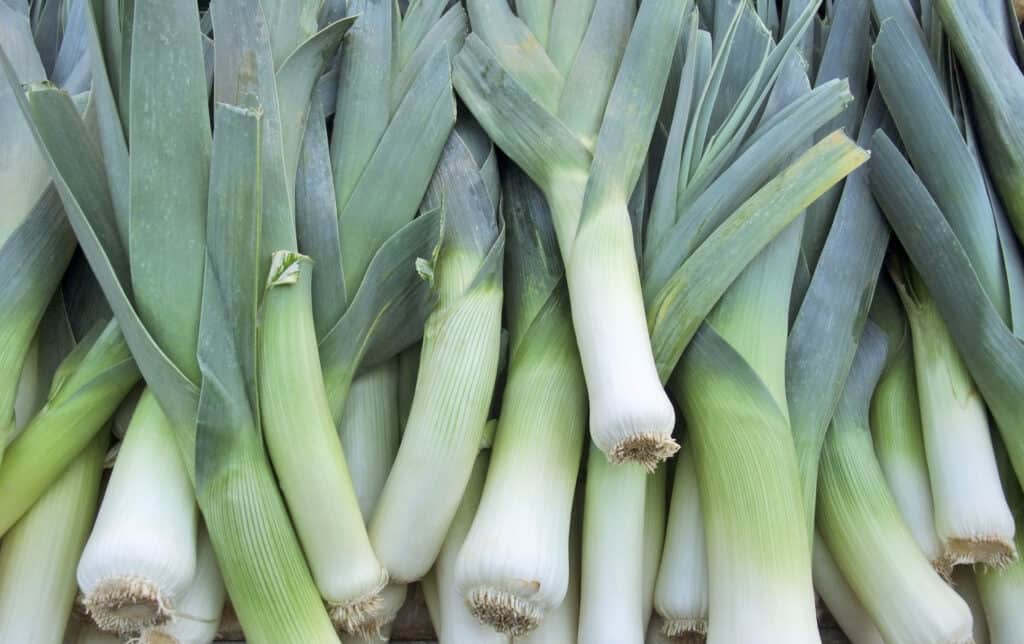
Poisoning can also build up in a dog’s system over days if they continue to consume small amounts.
©iStock.com/prill
Leeks are also part of the Allium family, and your dog may present with the same symptoms as with the veggies above–red blood cell damage, anemia, and GI upset.
Remember that if your dog eats various kinds of Alliums, they might still suffer from poisoning even if each veggie is eaten under the normal threshold for poisoning.
This is because they all contain the same toxic compounds. Poisoning can also build up in a dog’s system over days if they continue to consume small amounts.
6. Scallions
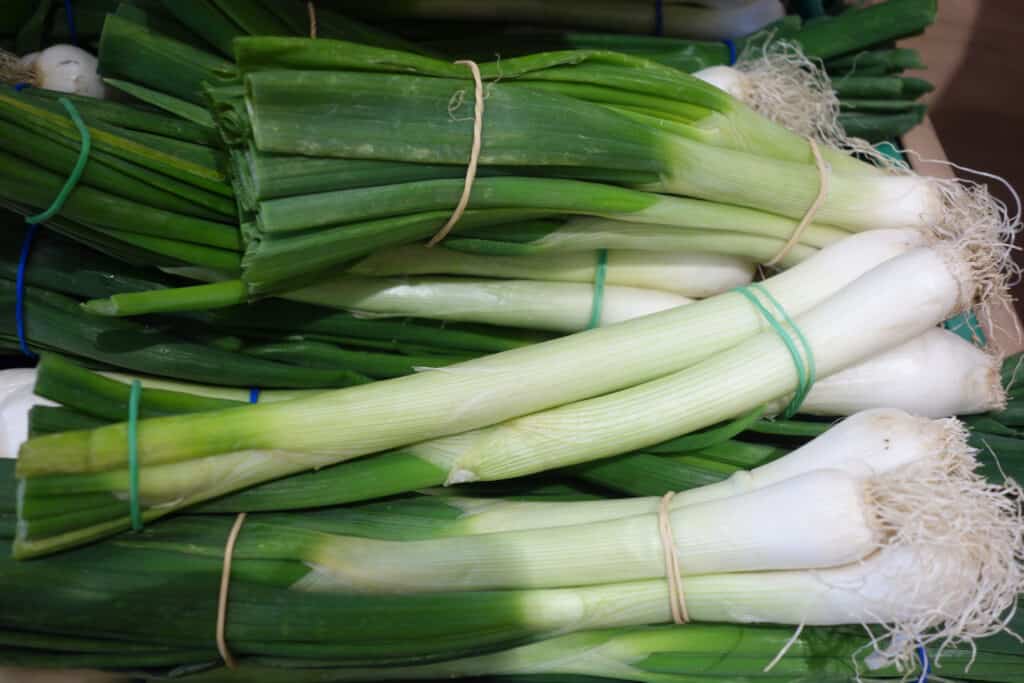
scallions are unsafe for your dog to eat.
©iStock.com/Elmar Gubisch
The last Allium vegetable on our list, scallions, is also unsafe for your dog to eat. If your dog consumes scallions, bring them to the veterinarian right away.
7. Rhubarb
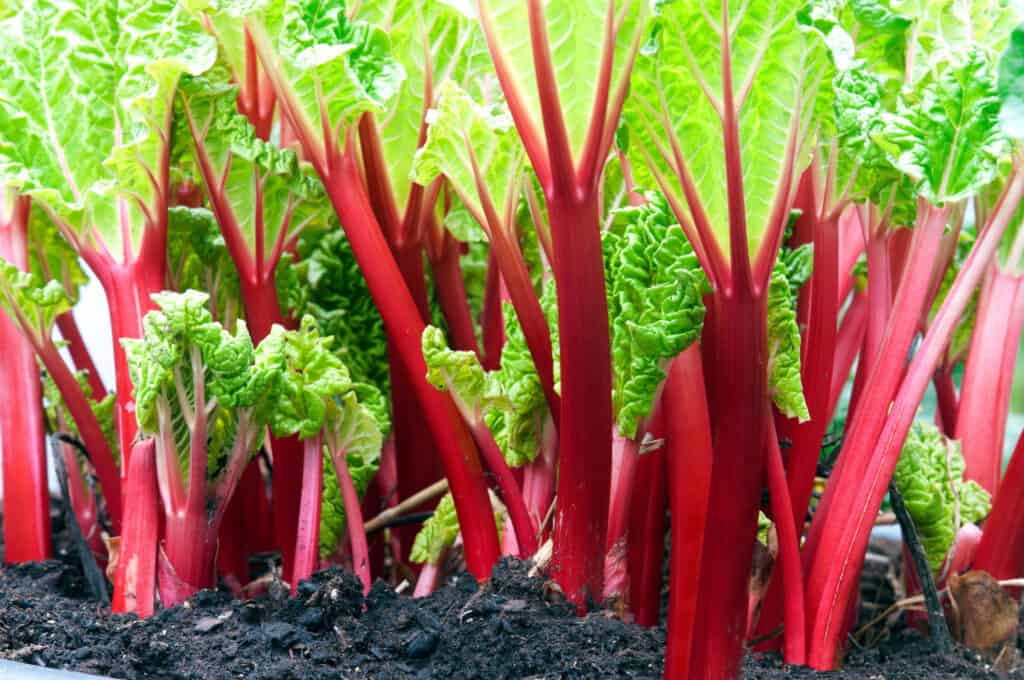
Kidney failure has been noted in dogs who’ve eaten large amounts of rhubarb.
©HVPMdev/Shutterstock.com
Rhubarb contains oxalic acid, which makes it toxic for dogs to eat.
Symptoms of rhubarb poisoning include drooling, vomiting, diarrhea, decreased appetite, tiredness, weakness, tremors, changes in thirst or urination, and blood in the urine. Kidney failure has been noted in dogs who’ve eaten large amounts of rhubarb.
If your dog eats rhubarb, call an emergency veterinary clinic or pet poison hotline immediately. Let them know how much your dog ate and if they’re currently showing any symptoms of poisoning.
8. Unripened Tomatoes

While ripened tomatoes are
safe for dogs to eat
, unripened tomatoes aren’t.
©Dr.E.Srinivas/Shutterstock.com
Tomatoes are technically fruits, but many people see them as vegetables. While ripened tomatoes are safe for dogs to eat, unripened tomatoes aren’t. The plant itself is also toxic to dogs.
Symptoms of tomato poisoning include upset stomach, lethargy, incoordination, lowered appetite, weakness, excessive drooling, dilated pupils, tremors, seizures, and cardiac problems.
According to the American Kennel Club, tomato poisoning is rare, and a dog would have to eat quite a bit to suffer adverse effects. Still, it’s best to consult with a pet poison hotline or veterinarian if your dog eats unripened tomatoes or any part of a tomato plant. Small dogs and puppies are most at risk for poisoning.
9. Raw Potatoes

Uncooked potatoes are toxic to dogs.
©Val_R/Shutterstock.com
Uncooked potatoes contain solanine, which is toxic to dogs. The levels of solanine in the potato go down when cooked, which is why we previously thought cooked potatoes were safe.
However, it seems that white potatoes may be linked to canine dilated cardiomyopathy (DCM), which is a heart condition. The FDA is currently studying the role of many fillers in grain-free dog foods to determine why they’ve been linked to an increased risk of heart disease.
Therefore, I would personally avoid feeding potatoes altogether until the FDA can fully study DCM and we know its cause.
10. Peas
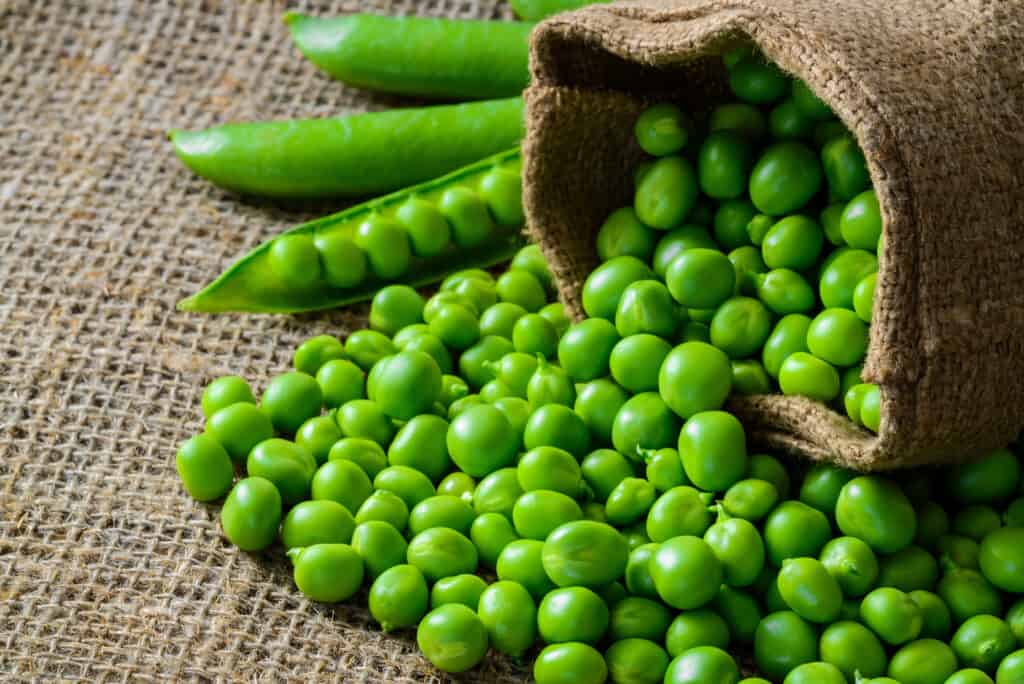
Peas are possibly linked to DCM in dogs.
©287797673/Shutterstock.com
While they aren’t toxic, peas are possibly linked to DCM in dogs. They might be okay in small amounts–current studies are focused on peas being used as a filler in grain-free dog foods.
Nevertheless, I recommend avoiding them until we have more information. It’s simply not worth the risk when other great veggies won’t hurt our furry friends.
11. Hot Peppers
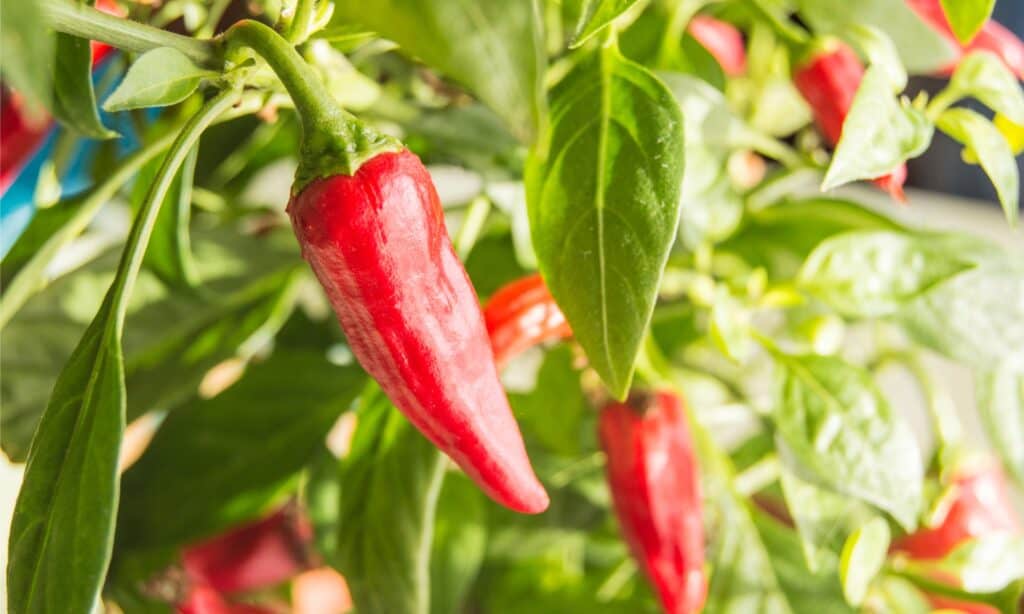
Dogs can’t tolerate spicy foods and also don’t enjoy eating them.
©iStock.com/ClaireLucia
Also, not technically toxic, hot peppers can irritate your dog’s mouth, throat, and digestive system. Dogs can’t tolerate spicy foods and also don’t enjoy eating them.
Therefore, please avoid feeding hot peppers. Also, keep your dog out of the veggie garden if you’re growing pepper plants, as the leaves and stems are toxic to them.
Bell peppers and other sweet peppers are mostly okay for dogs, but please research the individual type of pepper to ensure you’re feeding one that’s safe.
What Vegetables Are Safe To Feed Dogs?
Luckily, there are a variety of dog-safe vegetables that we can turn to instead of the ones on this list. Vegetables make great healthy snacks for dogs, alongside fruits and small pieces of cooked unseasoned meat.
Some of the tastiest veggies to feed your dog include sweet potatoes, pumpkin, and carrots. Sweet potatoes contain large amounts of vitamin A, while pumpkin contains fiber to help regulate a dog’s digestive system.
Carrots are a favorite snack of many dogs. They can be fed in small pieces, which is preferable for small dogs and puppies. Large dogs can also eat them like they would a chew–some people even freeze them to make them a bit tougher.
This can keep your dog occupied, but please remember to always supervise your dog. If they try to swallow large pieces or the entire carrot, take it away and avoid giving them chews in the future.
Summary Of The 11 Vegetables That Can Poison Your Dog And Are Not Safe To Eat
| Rank | Vegetable That Can Poison Your Dog |
|---|---|
| 1 | Mushrooms |
| 2 | Onions |
| 3 | Garlic |
| 4 | Chives |
| 5 | Leeks |
| 6 | Scallions |
| 7 | Rhubarb |
| 8 | Unripened Tomatoes |
| 9 | Raw Potatoes |
| 10 | Peas |
| 11 | Hot Peppers |
The photo featured at the top of this post is © Dr.E.Srinivas/Shutterstock.com
Ready to discover the top 10 cutest dog breeds in the entire world?
How about the fastest dogs, the largest dogs and those that are -- quite frankly -- just the kindest dogs on the planet? Each day, AZ Animals sends out lists just like this to our thousands of email subscribers. And the best part? It's FREE. Join today by entering your email below.
Thank you for reading! Have some feedback for us? Contact the AZ Animals editorial team.






